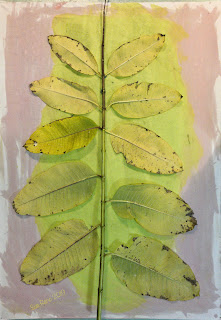I'm welcoming in the new year by continuing to catch up on prints I made towards the end of last year. Making prints from plants growing around my new home was a good way to familiarize myself with my new environment and fine tune my new studio setup.
First up in this batch is a stem of milkweed,
Asclepias syriaca. Ordinarily I would let it be, as a food source for invertebrates, but it was positioned in a portion of the garden that needed to be renovated so I sacrificed it to the printmaking gods.
For these prints I once again worked in a process I had experimented with last year, combining wet cyanotype with solar dye printing, specifically Jacquard's Solarfast. Above is the fabric before exposure, and below after a short stint in the sun under plastic.
Here is a section of wild grape/fox grape,
Vitis labrusca, also in progress.
Next I did some leaflets of honey locust,
Gleditsia triacanthos.
And two panels of American elm,
Ulmus americana, which I have never worked with before.
Here are the prints after exposure but before being rinsed out.
Sometimes if I do everything just right, I can retain brushstroke marks from the Solarfast.
These looked very promising!
Here are the final prints. The milkweed is fairly straightforward, red and blue.
This grape leaf print turned out beautifully, and is currently on my design wall awaiting my further attentions.
I'm also very pleased with the locust print.
And ditto for the elms. Aside from the milkweed, which is about 12" x 16", these are all larger panels, 20ish by 40ish. I'm enjoying the larger format.
And there you have it! I feel like combining the two processes is moving from "experimental" to "getting a handle on it".
If you are new here, I've been working with cyanotype since 2002, and with the wet cyanotype process since the summer of 2017. All the wet cyan posts, of which this is number 45, where I document my experiments in detail, are available in reverse chronological order by clicking the "Wet Cyanotype" tab in the header bar, or by going here.
And a reminder that you can also follow along on your social media of choice:
Facebook page:http://www.facebook.com/suerenostudio
Twitter feed: http://twitter.com/suereno
Tumblr: http://suerenostudio.tumblr.com
Instagram: https://www.instagram.com/sue_reno_studio/














































